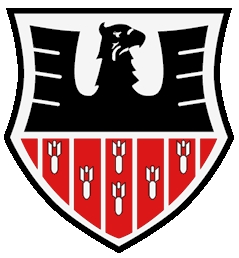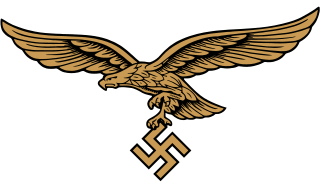
Jagdgeschwader 52 was a German World War II fighter-wing that exclusively used the Messerschmitt Bf 109 throughout the war. The unit originally formed near Munich in November 1938, then moved to a base near Stuttgart. JG 52 became the most successful fighter-wing of all time, with a claimed total of more than 10,000 victories over enemy aircraft during World War II. It was the unit of the top three scoring flying aces of all time, Erich Hartmann, Gerhard Barkhorn and Günther Rall.

Jagdgeschwader 5 was a German Luftwaffe fighter wing during World War II. It was created to operate in the far North of Europe, namely Norway, Scandinavia and northern parts of Finland, all nearest the Arctic Ocean, with Luftflotte 5, created specifically to be based in occupied Norway, and responsible for much of northern Norway.

Jagdgeschwader 77 Herz As was a Luftwaffe fighter wing during World War II. It served in all the German theaters of war, from Western Europe to the Eastern Front, and from the high north in Norway to the Mediterranean.
Sturzkampfgeschwader 2 Immelmann was a Luftwaffe Dive bomber-wing of World War II. It was named after Max Immelmann in 1939. The unit was originally formed as Fliegergruppe Schwerin in 1934; the first Stuka wing of its type, attaining the sobriquet 'Immelmann' in 1935. The wing was raised to gruppe status in 1939.
Schlachtgeschwader 2 Immelmann was a Luftwaffe dive-bomber wing of World War II. It was named after Max Immelmann, the first German pilot to earn the Pour le Mérite.

Luftflotte 1 was one of the primary divisions of the German Luftwaffe in World War II. It was formed 1 February 1939 from Luftwaffengruppenkommando 1 in Berlin. This Luftwaffe detachment served in Estonia, Latvia, Lithuania and Immola, Finland for air support of Axis forces in area; with command offices in Malpils, Latvia,, Eastern front.
Luftflotte 3 was one of the primary divisions of the German Luftwaffe in World War II. It was formed on 1 February 1939 from Luftwaffengruppenkommando 3 in Munich and redesignated Luftwaffenkommando West on 26 September 1944. This Luftwaffe detachment was based in German-occupied areas of Northern France, the Netherlands, Belgium, and Vichy France, to support the Axis power's forces in area. Its command offices were in Paris, France.

Jagdgeschwader 300 was a Luftwaffe fighter-wing of World War II. JG 300 was formed on June 26, 1943 in Deelen as Stab/Versuchskommando Herrmann, from July 18, 1943 as Stab/JG Herrmann and finally renamed on August 20, 1943 to Stab/JG 300. Its first Geschwaderkommodore was Oberstleutnant Hajo Herrmann.
An Erprobungskommando (EKdo) ("Testing-command") was a variety of Luftwaffe special-purpose unit tasked with the testing of new aircraft and weaponry under operational conditions. Similarly-named Erprobungs-prefixed squadron (staffel) and group (gruppe) sized units also existed at various times in the Luftwaffe during 1939-1944 to service-test new designs, usually numbered with the RLM aircraft designation system airframe number matching the aircraft they were meant to test, with the three digit number following the "8-xxx" RLM airframe number designating the unit, as with Erprobungsstaffel 177, charged with testing the A-0 production prototypes of the Heinkel He 177A heavy bomber. The similarly-prefixed Erprobungsgruppe 210 was meant to have service-tested the Messerschmitt Me 210 twin-engined "destroyer" and light bomber, but that design's early aerodynamic problems caused the unit's transformation and expansion into SKG 210, a dedicated "fast bomber" unit using Bf 110s instead.
Nachtjagdgeschwader 2 was a German night fighter-wing during World War II. NJG 2 was formed on 1 September 1940 in Gilze en Rijen, from sub-units of Nachtjagdgeschwader 1 and Zerstörergeschwader 2.
Lehrgeschwader 1 formerly Lehrgeschwader Greifswald was a Luftwaffe multi-purpose unit during World War II, operating fighter, bomber and dive-bomber Gruppen. The unit was formed in July 1936 and operated the Messerschmitt Bf 109, Messerschmitt Bf 110, Dornier Do 17, Heinkel He 111, Junkers Ju 88 and Junkers Ju 87.
Lehrgeschwader 2 was a Luftwaffe unit during World War II, operating three fighter, night fighter, reconnaissance and ground support Gruppen (groups).
Zerstörergeschwader 26 "Horst Wessel" was a Luftwaffe heavy/destroyer Fighter Aircraft-wing of World War II.

Jagdgeschwader 301 was a Luftwaffe fighter-wing of World War II. The order to form JG 301 was issued on 26 September 1943 and formed on 1 October 1943 in Neubiberg with Stab and three Gruppen (groups) as a "Wilde Sau" single-seat night fighter unit.

Kampfgeschwader 26 "Löwengeschwader" was a German air force Luftwaffe bomber wing unit during World War II. Its units participated on all of the fronts in the European Theatre until the end of the war. It operated three of the major German aircraft medium bomber types; the Heinkel He 111, Junkers Ju 88 and the Junkers Ju 188. The unit engaged in both strategic bombing, close air support, anti-shipping and aerial interdiction operations. The majority of its operational life – not entirely unlike another Luftwaffe wing designated KG 40 — was spent on anti-shipping missions.

Kampfgeschwader 2 " Holzhammer " was a Luftwaffe bomber unit during the Second World War. The unit was formed in May 1939. The unit operated the Dornier Do 17 light bomber, Dornier Do 217 and Junkers Ju 188 heavy bombers. During the course of the Second World War KG 2 lost 767 aircraft destroyed and 158 damaged. According to H.L. de Zeng at al, it suffered 1,908 personnel killed in action or missing in action and 214 as prisoners of war. Broken down further, for the duration of the war KG 2 lost 1,228 killed, 688 missing, 656 wounded and with 214 captured, for a total of 2,786 in both combat and non-combat operations.

Kampfgeschwader 6 was a Luftwaffe bomber unit during the Second World War. The unit was formed between April and September 1942 and was equipped with Dornier Do 217, Junkers Ju 188 and Junkers Ju 88 bombers.

Kampfgeschwader 30 was a Luftwaffe bomber wing during World War II.

Zerstörergeschwader 1 was a Luftwaffe heavy/destroyer Fighter Aircraft-wing of World War II.

Schnellkampfgeschwader 10 was a Luftwaffe fast bomber wing of the Second World War. The unit was initially created with three Gruppen (groups) in December 1942 at Saint-André-de-l'Eure Airport and augmented by a fourth group on 10 April 1943.













